Ah, February, the single most dreadful time of the year for all things FC Barcelona. While a certain dose of superstition definitely plays a huge role in believing in what Cules popularly call “Hlebruary”, some facts simply cannot be totally overlooked. The Catalans do struggle just around the second month of the year and going into the third every single year.
Be it superstition, a tough schedule, bad management or just a certain dose of bad luck, Barcelona and February do not get along, as can be seen from no wins from their three games this month. Until the game against Real Valladolid, that is.
This February-specific dip in form was also seen in all its glory against a team that is fighting relegation in La Liga. Nevertheless the hosts managed to get the all-important three points at the Camp Nou. This tactical analysis will use statistics to tell you just how Barcelona got away with a poor performance but also with the full spoils for themselves.
Lineups
Barcelona (4-3-3)
Starting XI: Ter Stegen – Sergi, Pique, Vermaelen, Alba – Aleña, Busquets, Vidal – Messi, Boateng, Dembele
Bench: Iñaki Peña, Lenglet, Semedo, Coutinho, Rakitić, Suárez, Malcom
Coach: Ernesto Valverde
Real Valladolid (3-4-1-2)
Starting XI: Masip – Joaquin, Kikio Olivas, Calero – Antoñito, Michel, Anuar, Nacho – Verde – Sergi Guardiola, Enes Ünal
Bench: Yoel, Boarja, Moyand, Toni, Duje Cop, Keko, Stiven Plaza
Coach: Sergio Gonzalez
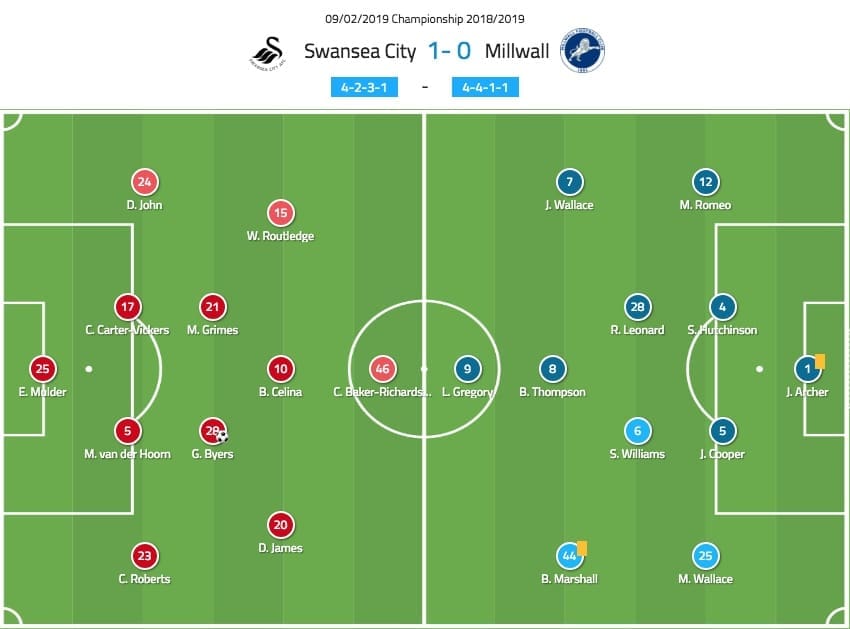

Barcelona’s setup
Seeing how there are some crucial fixture ahead of the team, Ernesto Valverde had to find the perfect games to rest his key players. On paper, the game against relegation-bound Real Valladolid seemed like a perfect option.
Thomas Vermaelen replaced Clement Lenglet and formed a centre-back pairing with Gerard Pique, who was making his 300th appearance for the Catalan giants in La Liga. Moving a bit higher up the pitch, Carles Alena got another start in the starting XI, and Ivan Rakitić was moved to the bench. Next to the young La Masia gem were Sergio Busquets and Arturo Vidal.
Up front, Ousmane Dembele returned alongside Camp Nou debutant Kevin-Prince Boateng, who was finally given some more minutes. Lionel Messi also started and finished the match in front of the home crowd.
The team played in a 4-3-3 shape throughout the match with no evident changes.
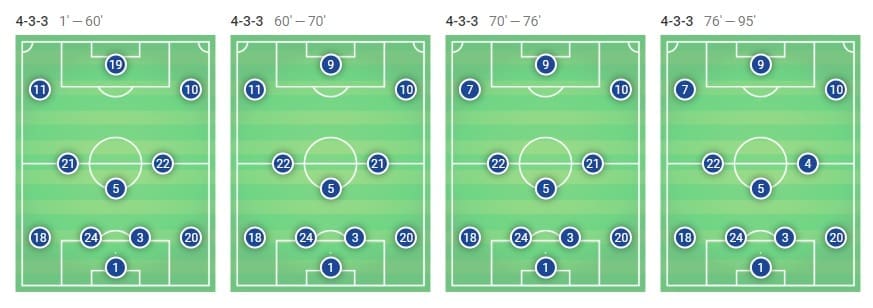
Real Valladolid’s setup
Being cemented to the bottom half of the La Liga table for the majority of this season, the visitors had all to play for at the Camp Nou. But as it turns out, winning in the Catalan capital is a task easier said than done. Bearing that in mind, Gonzalez’s troops had a more defensive mindset which ended up shaping their lineup as well.
The away team had four men missing but none really interfered with the grand scheme of things on the pitch. A new formation, used only a meagre 5% of the time for Valladolid so far this season, also meant an experiment of sorts in personnel.
The back three consisted of Fernandez, Kiko and Calero, and behind them was ex-Blaugrana man Jordi Masip, who proved to be the crucial piece of the jigsaw. The middle of the park was a particular focal point for the visitors and featured a quartet consisting of Antonito, Michel, Tuhami and Nacho, as Verde played the role just behind the forwards.
The attacking tandem was made out of Guardiola and Unal, the only men to stay higher up the pitch at most times during the game. Sergio Gonzalez opted for an interesting 3-4-1-2 setup and remained faithful to it, only changing it when in transition.
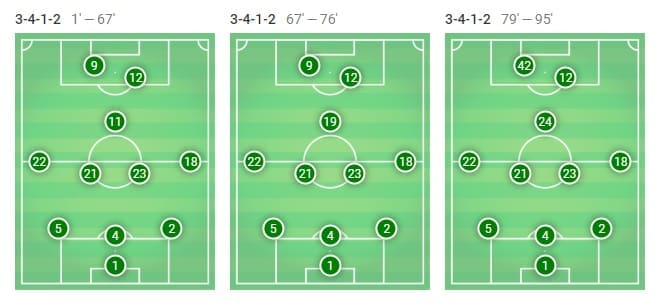
One way traffic
Real Valladolid knew that going for a miraculous upset at the Camp Nou was quite a tall order for a team fighting to stay afloat in the domestic league altogether. As a result, Sergio Gonzalez had only one thing in mind: defending. The visitors were fine with letting Barcelona take control of the game and the ball while they sat back and tried to survive the rollercoaster for the whole 90 minutes.
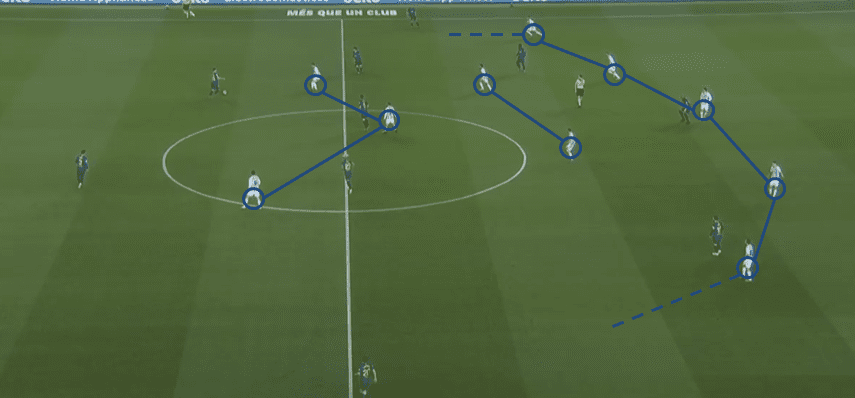
As can be seen from the example above, Valladolid formed a wide medium-to-high block to welcome the red and blues to their own half of the pitch. The main thing was to stop the overlapping full-backs who are Barcelona’s only true way of getting width.
The way they decided to combat that was to set up a back line consisting of five players when defending, and then pull the wide defenders up when transitioning into the attacking phase. When defending, Antonito and Nacho would drop from their respective flanks to the full-back positions to force Barcelona into the centre of the field and block their progress through the wings.

Note how Messi and Roberto swap positions to create a hole in the line but Valladolid’s defence responds in the same manner. Lionel Messi drags Nacho to create a pocket of space for Roberto to exploit but Sergi Guardiola follows Roberto and covers for his missing teammate.
The plan seemed to work for the visitors as Barcelona found little success breaching the wings and the five-man defensive line at the back. As the Catalans were forced through the middle, they were met with a crowd of Valladolid players around the centre of the park. Achieving numerical superiority was then the next step to successfully stop their progress.
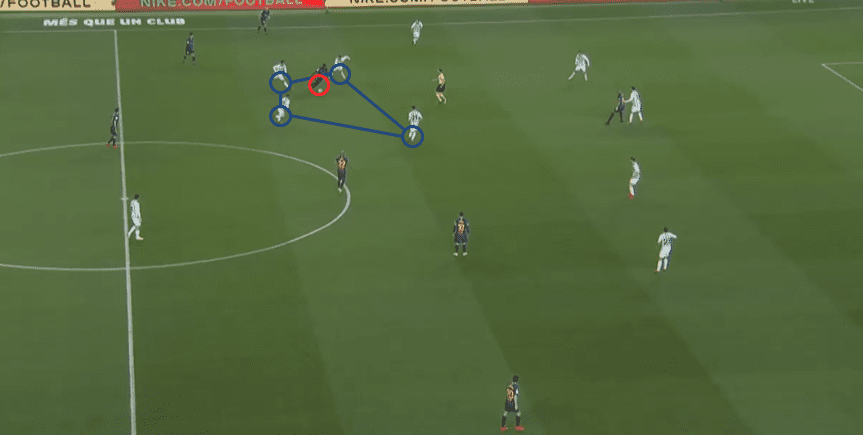
Even though Valladolid had a distinct system in place for both defensive and attacking phases, their setup was an extremely fluid one with forwards often dropping deeper to assist the midfield and the same thing happening the other way around.
The key for overcoming that for the hosts was a quick and fluid transition, which seemed to be the only thing missing from their game. While they didn’t have to worry that much about their own net, moving the ball with precision and stringing good passes together was strangely difficult for Barcelona.
At one point, their accuracy was below 80%, dropping to 78% with low and high points alternating regularly. A lot of that was due to individual errors and trying to create chances in difficult situations, resulting in yet another match with a lot of lost balls (89 in total).
Firing blanks
But as much as it is usually difficult for Barcelona to breach compact low blocks, especially when their full-backs are somewhat reserved as they were against Real Valladolid, this was not one of those instances where the Catalans couldn’t create enough chances. The problem was solely in finishing them.
Valladolid were great at stopping the overlaps and forcing Barcelona through the middle but their extremely wide formation had a certain weakness in the system. At times, too much space was afforded for deep runs behind the back line. With good movement, the Catalans exploited this to get into favourable situations.
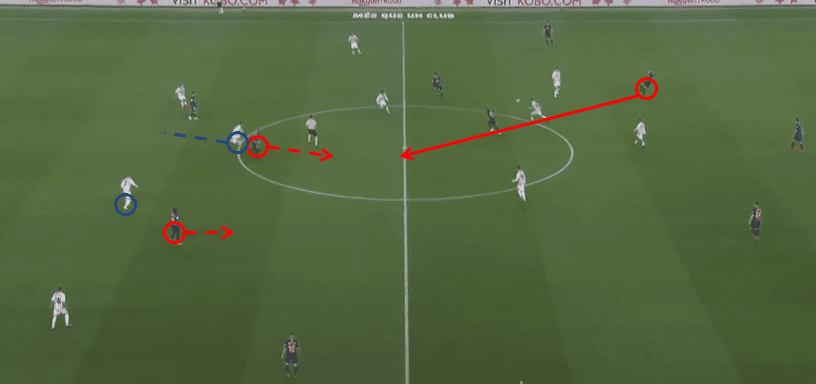
With one good movement, dragging his marker with him deeper, Kevin-Prince Boateng creates a gaping hole in the backline. Ousmane Dembele does the same but more subtly, and prepares for a quick change in direction. With enough space behind, the young Frenchman can burst into it with speed to escape the usually tight man-marking system. The result is a clear chance at goal.
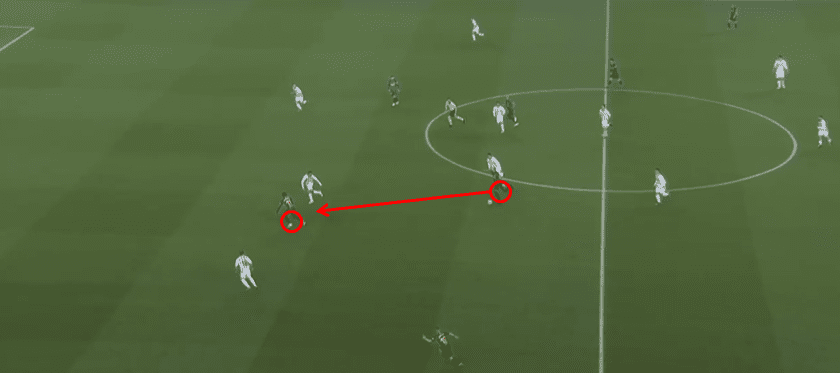
In this scenario, the system that had been keeping Valladolid safe was used against them. Their insistence on keeping a wide line in order to cover the flanks made them vulnerable in situations when someone was dragged away with no one to replace them. Boateng created a great chance by simple movement manipulation, and Dembele was there to exploit it.
Notice how neither the full-back nor the centre-back are close (or fast) enough to close in on the speeding Frenchman. The former had to keep an eye on Alba, and the latter was left in a unfavourable one-on-one scenario, which Valladolid were aiming to avoid at all costs.
But even though Barcelona had trouble keeping the ball at all times due to their own errors, they were pretty good at snatching it away in favourable situations. On those rare occasions when the away team were on the ball (they held just 38.82% possession), Barcelona would press immensely, and block all outgoing channels straight off.
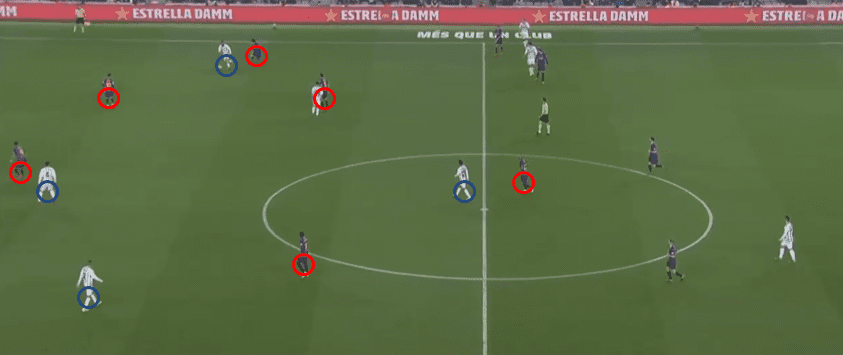
Valladolid try and build from the back but are met with too many Barcelona players in their own half. With everyone covered, they have to resort to going back towards their goalkeeper but at this point, that was an expected move.
Notice how the centre-back pairing has moved higher up the pitch in an attempt to escape the press but that leaves Luis Suarez all alone behind them with no marker.
The away team had to be progressive in order to get away from this situation but the safer choice ended up being the more costly one. Messi steals the ball away with a smart interception and sends the Uruguayan into a one-on-one situation with the keeper. Suarez is denied by Jordi Masip, and it would be far from the last time on the night.
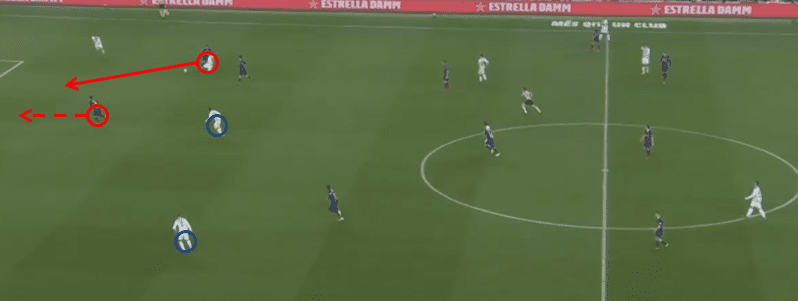
That situation is actually a good analysis of the game, altogether. Real Valladolid were in their shell soaking up all the pressure but there were certain leaks in their defence, and Barcelona were ready to pounce.
As a result, the Catalans created a total of seven big chances, four of which were orchestrated by Lionel Messi, and managed to miss all seven of them. To be more precise, Jordi Masip made seven big saves on the night, including from the penalty spot, denying Messi his second goal of the game.
Speaking of the Argentine, Messi had a pretty average game by his own high standards. The little magician led the team in both good and bad categories. He created the most chances (eight, four big ones), took the most shots (12), had a 100% shot participation with either taking them himself or assisting them. On the other hand, he also contributed the most losses (14), and missed a penalty. It was quite a weird night, showing that even Leo Messi is human after all.
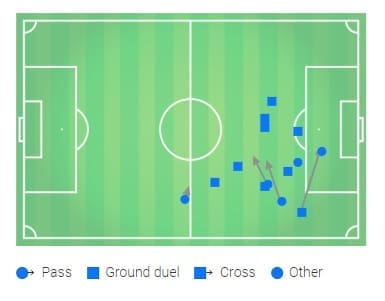
As for Real Valladolid, they were not really in the game per se, counting on sporadic counter-attacks to spice things up. Considering how Barcelona were struggling to kill the game off, they were one great chance away from making a complete mess for the hosts at the Camp Nou.
Unfortunately, that clear-cut chance never arrived as Valladolid were held to zero shots on target, and with eight unused counters, which were supposed to be their greatest weapon. In the end, the man between the sticks took that title as the attacking outlets of the visitors remained blunt throughout the game.
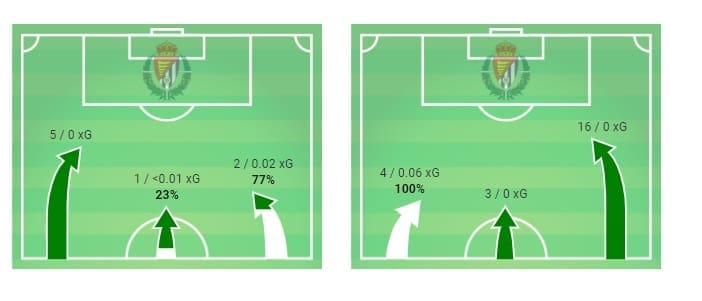
Conclusion
It was quite the night at the Catalan fortress which was both odd and unexpected. On paper, this was supposed to be an easy win for Barcelona but they instead fired blanks on all cylinders, managing to squander every single chance they got. Considering they had plenty, that says a lot.
Nonetheless, Messi grabbed the three points for his team from the spot to secure what turned out to be a vital win as their rivals Real Madrid were surprised by Girona at the Santiago Bernabeu.
On a different night, the scoreline could’ve been much, much different than it was but at the end of the day, victory is all that matters. What exactly were the factors behind a rather lacklustre performance from Barcelona? They could be saving their energy for the upcoming clash with Lyon, it could have been just a bad night or it might be Hlebruary after all.
Be that as it may, the Catalans will have to wake up sooner rather than later because the Champions League is back, and it doesn’t tolerate any dips in form or bad cases of superstition.
Europe is knocking on the door. Let’s see if Barcelona answer.
If you love tactical analysis, then you’ll love the digital magazines from totalfootballanalysis.com – a guaranteed 100+ pages of pure tactical analysis covering topics from the Premier League, Serie A, La Liga, Bundesliga and many, many more. Buy your copy of the February issue for just ₤4.99 here, or even better sign up for a ₤50 annual membership (12 monthly issues plus the annual review) right here.

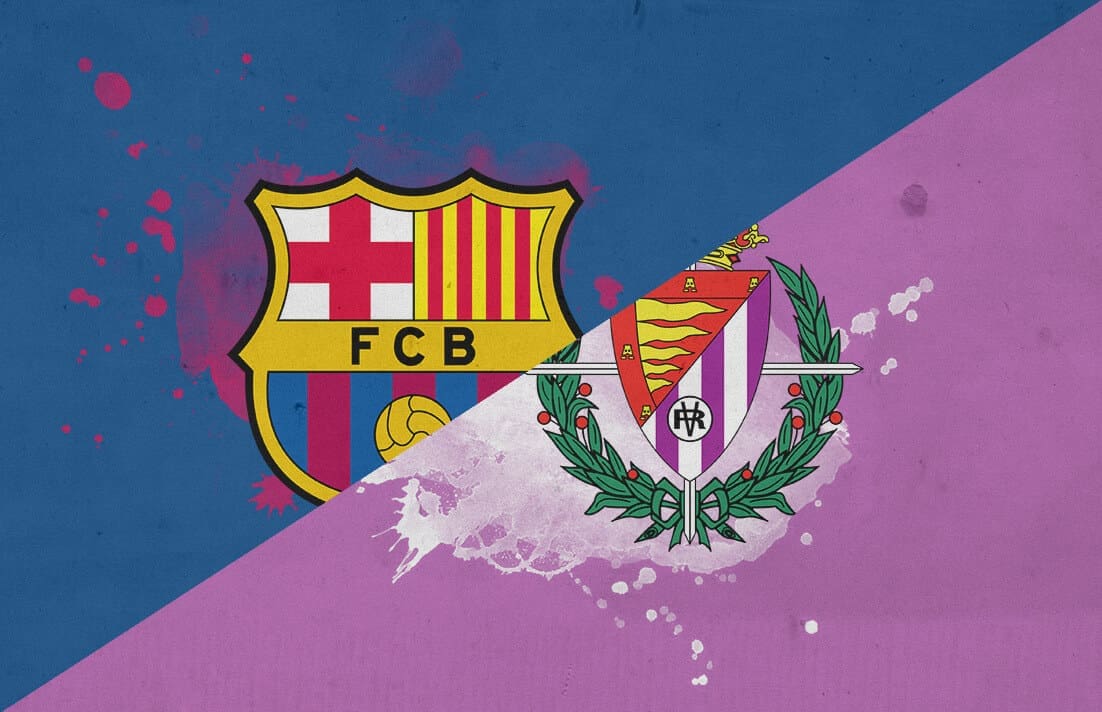




Comments